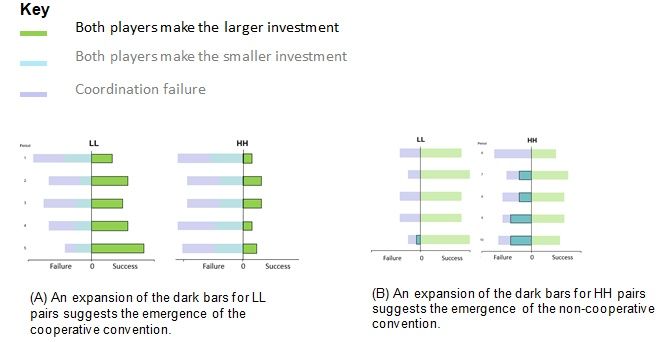In many parts of the world, we observe persistent dysfunction in learning to cooperate around common interests. Cultural differences – ideas of what constitutes an insult and what an appropriate response is – may have a role to play. Based on an experimental repeated coordination game among high- and low-caste men in rural Uttar Pradesh, this article shows that most low-caste pairs quickly establish an efficient and cooperative convention, while most high-caste pairs do not.
In experiments with US university students, an efficient and cooperative convention usually emerges quickly when small groups of individuals with common interests interact repeatedly. If the groups grow slowly, the efficient conventions can be sustained (Van Huyck et al. 1990, Weber 2006). However, in many parts of the world, we observe persistent dysfunction in learning to cooperate around common interests.
To shed light on possible cultural impediments to learning to cooperate, my co-authors and I undertook an experiment in 10 villages in Uttar Pradesh (UP) with 122 high- (general) and low (scheduled)-caste men (Brooks, Hoff and Pandey 2018). The evidence suggests that the construal and response to a loss from coordination failure are heavily influenced by cultural differences – that is, by ideas that vary across groups of what constitutes an insult and what is the appropriate response. Consistent with other recent work (for example, Henrich et al. 2010), we find evidence that culture matters in economic behaviour.
Playing a repeated coordination game with high- and low-caste men
From each of the 10 villages, we recruited representative samples of men from high and low castes. Each subject played a set of five rounds of the coordination game (the ‘Stag Hunt’) with an anonymous player of the same caste status and another set of five rounds with a player of different caste status. Each player was told whether his anonymous partner was high or low caste, and we randomised the order of the sets.
Our team of experimenters described the Stag Hunt to participants like this: You can choose between a larger or a smaller investment in a joint project. Making the larger investment yields a high return if the other player also makes the larger investment, but you will lose money (half of your endowment for the period) if the other player makes the smaller investment. Making the smaller investment yields the same low return to the investor no matter what the other player does.
The game presents a very simple problem of learning how to cooperate. The players have common interests. Both will want to make the larger investment as long as they believe that their partner will also make the larger investment.
UP is a good place to study the effects of culture on convention formation because people from two broad cultures – high and low castes – live in the same villages; and the villages, which are dominated by the high castes, have remarkably inefficient conventions. Jean Drèze and colleagues (Drèze and Gazdar 1997, Drèze and Sharma 1998) describe the situation as political and social inertia. Villagers do not coordinate on tasks of common interest, such as timing the planting of crops to maximise output, draining household waste water to keep dirt paths dry and safely passable, and sanitation.
But the disadvantage of using high and low castes to study the impact of culture is that the two groups differ in many ways besides culture – in particular, in wealth, education, and political power. We control for wealth and as many other differences as we can. Seventy years after India’s independence, there are high-caste households that are poor and low-caste households that are well-off.
What did we see?
Only in the low castes did most pairs of men quickly form a cooperative convention – see Panel A of Figure 1. By period 5, two-thirds of low-caste pairs (denoted LL) were cooperating, and in the last period (period 10), 80% were.
In contrast, most high-caste pairs (denoted HH) did not form a cooperative convention and there was no increasing trend in cooperation by people in fixed pairs over periods 1-5 or periods 6-10. In period 5, less than one-fifth of HH pairs were cooperating; in period 10, under one-half were cooperating. The HH pairs that were not cooperating were either in coordination failure or in the inefficient equilibrium wherein both players make the smaller investment. The inefficient, non-cooperative convention appears to have emerged in one-third of the HH pairs by period 10 (see Panel B). Compared with HH pairs, mixed-caste pairs (HL) were more likely to be in the cooperative equilibrium.
Figure 1. Results of a repeated coordination game played with high- and low-caste men in UP
 Note: Recall that the observations in panel A are for different individuals than the observations for panel B. Participants in the HH or LL pairs in periods 1-5 were in mixed caste pairs (HL) in periods 6-10, and participants in the HH or LL pairs in periods 6-10 were in HL pairs in periods 1-5. Thus, the observations in panels A and B are for distinct groups of players.
Note: Recall that the observations in panel A are for different individuals than the observations for panel B. Participants in the HH or LL pairs in periods 1-5 were in mixed caste pairs (HL) in periods 6-10, and participants in the HH or LL pairs in periods 6-10 were in HL pairs in periods 1-5. Thus, the observations in panels A and B are for distinct groups of players. What is interesting to note is that high- and low-caste players behaved in very similar ways in all periods except: (i) the first period (when the proportion who made the larger investment was 68% for low-caste compared to 53% for high-caste participants) and (ii) the period after a player incurred a loss from a coordination failure. Why the difference in response to a loss? The high- and low-caste players appear to interpret the loss differently or, if they interpret it in the same way, to differ in their preference for retaliation. Since the loss would have been avoided if the other player had cooperated, it could be categorised as an insult, for which the culturally appropriate response for a high-caste man is retaliation. Further, high-caste men expect other high-caste men, but not low-caste men, to act morally and hence, feel more insulted if a loss is imposed by a high-caste man rather than a low-caste man.
Is retaliating a luxury? Can one explain why the high-caste men retaliate more than the low-caste men by their having greater average wealth? The answer is no. When we restrict the sample to the poorest players – those who live in thatched mud huts – the gap between high and low-castes in the response to the loss from coordination failure is larger. Among players who live in mud huts, the probability of continuing in the next period to make the larger investment after incurring a loss is 72 percentage points lower in HH than LL pairs. In contrast, among players who do not live in mud huts, the probability of continuing in the next period to make the larger investment after incurring a loss is only 38 percentage points lower in HH than LL pairs. Viewing retaliation as a luxury or as an expression of feelings of entitlement of the rich cannot explain why high-caste participants disproportionately retaliate. In our experiment, the feeling of entitlement and desire to retaliate are associated with high caste, not high class. Poor high-caste men were the least able to form the efficient convention.
To further examine the link between caste status and cultural norms for retaliation, we implemented a vignette-based survey using representative samples of high- and low-caste men from each of 22 hamlets in UP. We presented individuals with two hypothetical scenarios in which a man named Dinesh behaves in a way that harms a man named Mahesh, who retaliates violently by beating him. For each of the two scenarios, we asked each person in the sample how he would respond to the harm. In cases in which there is ambiguity in the motives of the person who inflicts the loss, a much larger proportion of high-caste than low-caste respondents said they would retaliate aggressively. Typical aggressive comments were, “I would do tit for tat, otherwise people will think I am weak" and “it is wrong to cause a loss." The caste difference in the responses to the vignette-based survey is consistent with ethnographic work, which documents a much greater concern for status and honour among high castes than among low castes.
In a culture of honour, ‘honour’ is synonymous with a reputation for responding aggressively to perceived offenses. This reputation, it is believed, deters others from challenging one’s authority or position.
What you see depends on what ideas are most accessible
Construal is an underutilised concept in explaining economic behaviour. Individuals do not respond to objective situations; they respond to situations as they perceive and interpret them.
An example that illustrates how the accessibility of different concepts affects perception is the following: What do you see in the image below?
When asked in October, most of the experimental subjects, recruited as they entered the Zurich zoo, said it was a bird, but when asked on Easter Sunday, most said it was a bunny. Expectations have a biasing effect on perception (Brugger and Brugger 1993). The bunny is very accessible to Westerners at Easter, but not in the fall. Thus, at Easter most see in the figure a bunny, and in the fall most see a bird (the type of bird most often named was a duck).
High-caste boys in villages are often taught from an early age to take revenge against slights. This makes honour a very accessible concept to high-caste males. A culture of honour has been described as a “mediative concept” through which individuals interpret reality (Pitt-Rivers 1966). This culture is stronger among high castes than low castes in rural North India. It is strong in many groups around the world, for example, white men in the US South and gang members in US ghettos (Nisbett and Cohen 1996, Heller et al. 2017). A Milwaukee police chief described a culture of honour in violent underclass communities in his city this way: “Maintaining one’s status and credibility and honor, if you will, within that peer community is literally a matter of life and death” (Davie and Smith 2015). A wonderful novel about an ancient culture of honour is Kadare’s (1990) ‘Broken April’.
The evidence suggests that the explanation of the caste gap in learning to cooperate in our experiment is that many high-caste men construe their losses from coordination failures as insults instead of innocent mistakes. They have been taught to retaliate against insults. Retaliating in the coordination game (by making the smaller investment in the joint project) makes it more difficult for the two players to converge on expectations that they will both make the larger investment.
Policy implications of economic mobility
Since economic development increases mobility, both upward and downward, it increases the vulnerability to a relative decline in social class and status. The poor, high-caste subjects in our experiment – people whose ancestors were presumably high in the distribution of income – were the least able to learn to cooperate. This suggests that economic development is likely to exacerbate problems of poor coordination in rural North India.
Our findings suggest new kinds of policies to address the problem. Policies can change how people construe situations and how they respond to them. There have been successes in interventions to change construal in ways that reduce violence by young males with a culture of honour in Chicago ghettos (Heller et al. 2017), and to reduce conflicts among claimants to land in post-civil war Liberia (Blattman, Hartman and Blair 2014). In the Chicago area, three randomised controlled trials of interventions taught disadvantaged males to think twice before responding aggressively to assertions of authority. The interventions increased participants’ high school graduation rates by 6-9 percentage points and reduced their violent crime arrests during the programme period by 44-50%.
Our finding that high-caste men often retaliate against losses from an innocent coordination failure, and that their aggressive response impedes their ability to learn to cooperate in repeated interactions in a game of common interest, suggests the value of similar kinds of interventions to change construal in villages in North India.
Further Reading
- Blattman, Christopher, Alexandra Hartman, and Robert Blair (2014), “How to promote order and property rights under Weak rule of law? An experiment in changing dispute resolution behavior through community education”, American Political Science Review, 108(1): 100-120.
- Brooks, Benjamin A, Karla Hoff and Priyanka Pandey (2018), “Cultural Impediments to Learning to Cooperate: An Experimental Study of High- and Low-Caste Men in Rural India”, Proceedings of the National Academy of Sciences, 115(45): 11385-11392.
- Brugger, Peter and Susanne Brugger (1998), “The Easter Bunny in October: Is it Disguised as a Duck?”, Perceptual and Motor Skills, 76(2): 577-578.
- Davey M and M Smith (2015), ‘Murder Rates Rising Sharply in Many Cities’, New York Times, 31 August.
- Drèze, J and H Gazdar (1997), ‘Uttar Pradesh: The burden of inertia’, in J Dreze and A Sen (eds.), Indian Development: Selected Regional Perspectives, Oxford University Press, New York, 33-128.
- Drèze, J and N Sharma (1998), ‘Palanpur: Population, society and economy’, in P Lanjouw and N Stern (eds.), Economic Development in Palanpur over Five Decades, Oxford University Press, New York, 3-113.
- Grosjean, Pauline (2014), “A History of Violence: The Culture of Honor and Homicide in the US South”, Journal of the European Economic Association, 12(5):1285-1316.
- Heller, Sara B, Anuj Shah, Jonathan Guryan, Jens Ludwig, Sendhil Mullainathan and Harrold Pollack (2017), “Thinking, fast and slow? Some field experiments to reduce crime and dropout in Chicago”, Quarterly Journal of Economics, 132(1): 1-54.
- Henrich, Joseph, Jean Ensminger, Richard McElreath, Abigail Barr, Clark Barrett, Alexander Bolyanatz, Jual Camilo Cardenas et al. (2010), “Market, religion, community size and the evolution of fairness and punishment”, Science, 327(5972): 1480-1484.
- Kadare, I (1990), Broken Apart, New Amsterdam Books, Chicago.
- Nisbett, R and D Cohen (1996), Culture of honor: The psychology of violence in the South, Westview Press, Colorado.
- Pitt-Rivers, J (1966), ‘Honor and social status’, in JG Peristiany (ed.), Honor and Shame: The Values of Mediterranean Society, Chicago University Press, Chicago, 19–77.
- Weber, Roberto A (2006), “Managing growth to achieve efficient coordination in large groups”, American Economic Review, 96(1): 114-126.
- Van Huyck, John B, Raymond C Battalio and Richard O Beil (1990), “Tacit coordination games, strategic uncertainty, and coordination failure”, American Economic Review, 80(1): 234-248. Available here.




 20 February, 2019
20 February, 2019 





Comments will be held for moderation. Your contact information will not be made public.